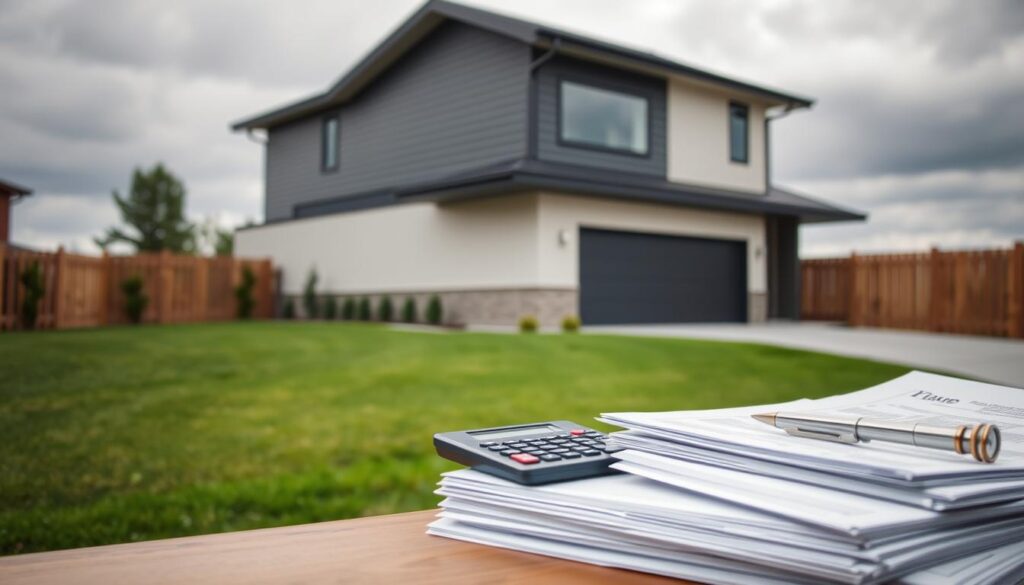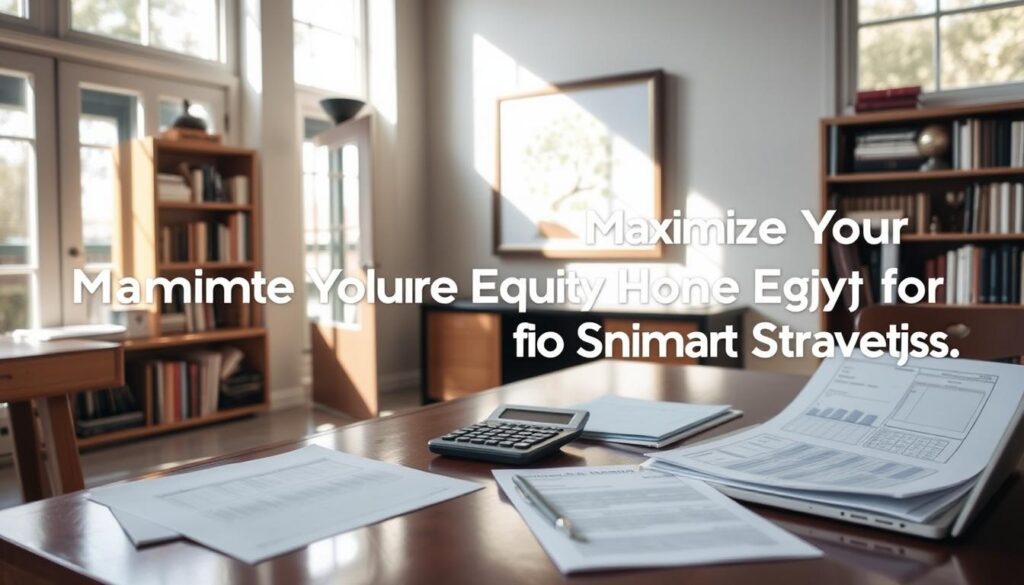Did you know U.S. homeowners gained $1.6 trillion in home equity in 2023 alone? CoreLogic reports an 8% year-over-year surge, with the average homeowner holding $320,000 in equity. This growing asset isn’t just sitting idle—it’s reshaping how Americans approach financial decisions.
With mortgage rates near historic lows and housing inventory at a 20-year tightness, now’s the time to understand home equity trends. Experts like CoreLogic’s Chief Economist Dr. Selma Hepp note this surge isn’t accidental. Rising home values and strategic borrowing are empowering homeowners to refinance, renovate, or fund life goals without selling property.
But how do these home equity trends impact your wallet? Let’s explore the numbers behind this boom and uncover actionable steps to turn your home’s value into opportunities. From tax benefits to renovation ROI, this guide simplifies complex concepts to help you make informed choices.
Understanding Home Equity: A Friendly Guide
Home equity is the portion of your home’s value you truly own. Imagine buying a house for $200,000 with a $150,000 mortgage. Your equity starts at $50,000 and grows as you pay down debt or home values rise. For modern homeowners, this equity acts as a financial tool. Recent data shows the average U.S. homeowner holds nearly $299,000 in equity, part of a national total exceeding $32 trillion.
What is Home Equity?
- Calculated as current home value minus remaining mortgage balance
- Builds over time through payments and market appreciation
The Benefits for You
Equity offers flexibility. Many modern homeowners use it to:
- Refinance for lower rates
- Consolidate high-interest debt (like the $1.12 trillion in auto loans outstanding)
- Finance home improvements boosting resale value
| Statistic | 2024 Figures |
|---|---|
| Average home equity | $299,000 |
| Total U.S. home equity | $32 trillion+ |
| Outstanding credit card debt | $1.12 trillion |
Understanding equity empowers decisions. Whether planning repairs or managing debt, this hidden asset can shape your financial strategy. Start by estimating your equity with online calculators to see opportunities tailored to your situation.
Assessing Your Home’s Value and Equity Growth
Knowing your home’s worth and tracking equity growth starts with simple steps. Use these tools to stay informed:
- Request a professional appraisal every 2–3 years to set a baseline.
- Compare local sales using Zillow or Redfin for real-time market data.
- Track payments: Each mortgage payment increases your equity through amortization.
Market trends directly impact equity growth. CoreLogic reports show U.S. home values rose 8% in 2023, boosting average equity by $75,000. Tools like ICE Mortgage Monitor reveal how paying down debt accelerates this process.
| Factor | Impact |
|---|---|
| Location | Highest equity gains in cities like Austin (+12%) and Denver (+10%) |
| Home improvements | Kitchens and bathrooms add 5–7% value annually |
| Loan terms | Shorter mortgages build equity faster |
Monitor equity growth quarterly using online calculators. Combine appraised value with loan payoff amounts to see your current equity. For example, a $300k home with a $150k loan has $150k equity. As the home appreciates, so does your equity share.
Trends and Insights in Home Equity Investment for Modern Homeowners
Today’s housing market offers new opportunities and challenges for homeowners. Let’s explore principles and trends shaping equity growth in 2024.
Key Investment Principles
Smart equity decisions start with core strategies:
- Focus on long-term appreciation
- Monitor market dynamics affecting home values
- Align investments with personal financial goals
Understanding Market Dynamics
Experts like CoreLogic’s Dr. Selma Hepp note that market dynamics like limited inventory and interest rate shifts directly impact equity. For example:
| Factor | Impact on Equity |
|---|---|
| Rising home prices | Boosts equity value |
| High mortgage rates | Slows equity growth |
| Local job growth | Increases demand, raising values |
Roger Ashworth of NAR predicts 3-5% home price appreciation in 2024. Track these trends to time your decisions wisely. Remember: Local market dynamics often differ from national averages—research your area’s unique conditions.
Navigating Financial Tools and Equity Loans
When tapping into home equity, choosing between loans like HELOCs or traditional options matters. Recent trends show HELOC originations increased by 15% in 2024, per Bankrate data. Compare features like flexibility, costs, and repayment structures to match your goals.
Comparing Different Loan Options
- HELOCs act like credit cards with a borrowing limit tied to your home’s value.
- Traditional loans give fixed lump sums but require full repayment over set terms.
- Ask: Do you need ongoing access or a one-time payment? Fees and withdrawal rules vary.
Assessing Interest Rates and Terms
HELOCs typically have adjustable rates linked to the prime rate, while fixed-rate loans lock in terms. For example, current HELOC rates average 5.2% (variable) versus 7.1% for fixed loans. Always check draw periods (when you can borrow) and repayment phases. Short-term projects may favor fixed rates, while HELOCs suit flexible spending.
Strategies to Maximize Your Home Investment
Smart investment strategies can turn your home into a dynamic asset. Start by focusing on upgrades proven to boost value. Kitchen and bathroom renovations, for example, often recoup over 70% of costs, according to the 2023 Cost vs. Value Report.
Renovation ROI and Value Boost
- Replace outdated kitchens with energy-efficient appliances to attract buyers.
- Add outdoor living spaces—patios or decks—yielding 120% ROI in many regions.
Capitalizing on Tax Benefits
Did you know home office upgrades qualify for deductions? Federal tax rules allow write-offs for mortgage interest and certain improvements. The IRS also offers credits for eco-friendly updates like solar panels, reducing taxable income.
Long-Term Financial Planning
Work with a financial advisor to align renovations with market trends. Track local housing data to anticipate demand. For instance, homes in growing neighborhoods see 5-8% annual equity growth when updated strategically. Prioritize projects that balance short-term costs with long-term gains.
How to Leverage Home Equity for Renovations and Repairs
Using equity loans to fund home improvements can turn your growing equity into actionable upgrades. Recent data shows 65% of homeowners now prioritize renovations financed through equity, boosting long-term value. Let’s break down practical steps to make informed choices.

Planning Your Renovation Projects
Start by mapping out your goals:
- Identify needs vs. wants. Focus on high-value projects like kitchens or bathrooms, which often recoup 60–85% of costs.
- Get contractor quotes and compare timelines. Prioritize projects that align with local market preferences.
- Secure permits and approvals before finalizing plans to avoid unexpected delays.
Budgeting and ROI Analysis
Match loan terms to your renovation goals. For example:
- Use equity loans with fixed rates for large projects like additions.
- Choose lines of credit for smaller, phased repairs.
| Project Type | Cost Range | Typical ROI |
|---|---|---|
| Kitchen Overhaul | $15,000–$50,000 | 80–85% |
| Bathroom Renovation | $10,000–$25,000 | 65–75% |
| Roof Replacement | $7,000–$12,000 | 85–95% |
Track expenses and compare projected costs with resale data in your area. Work with lenders to align repayment terms with your renovation timeline. Always ensure renovations match your neighborhood’s trends to maximize returns.
Avoiding Common Pitfalls in Home Equity Investment
Home equity investments can boost wealth, but avoid these traps. Overborrowing, hidden fees, and ignoring market risks threaten gains. Start by calculating your renovation ROI to ensure projects add value.
- Don’t borrow more than 10-15% of equity—excessive loans strain budgets.
- Market swings matter: the S&P 500 dropped 19.44% in 2022 but rose 23% in 2024.
- Missed calculations? A $50,000 loan at 9% interest costs $26,000 in interest alone over 10 years.
| Year | S&P 500 Return |
|---|---|
| 2024 | 23.31% |
| 2023 | 24.23% |
| 2022 | -19.44% |
| 2021 | 26.89% |
| 2020 | 16.26% |
Fluctuations like these mean investments need time to recover. Financial analysts warn against assuming steady gains. For example, a $50,000 loan’s $633 monthly payment plus $26,000 interest requires disciplined renovation ROI planning.
Always compare loan terms and market trends. Use calculators to ensure investments exceed borrowing costs. Patience and research protect your home’s value.
Monitoring Market Trends and Future Outlook
Staying informed about housing market shifts is key to smart financial planning. Regularly tracking trends helps you adapt strategies for growing equity and minimizing risks.
Interpreting Current Market Data
- Track CoreLogic reports for regional price forecasts and inventory levels.
- Compare mortgage rate trends from the Federal Reserve with local lender offers.
- Use tools like Zillow’s Home Value Insights to gauge neighborhood appreciation patterns.
Local vs National Trends
National data shows average home prices up 8% in 2023 (CoreLogic), but local conditions vary:
- Local Focus: Check city-specific job growth rates and zoning changes affecting your area.
- National View: Monitor interest rate cycles and federal housing policies impacting borrowing costs.
Blend both perspectives to refine your long-term goals. Subscribe to industry newsletters like Realtor Magazine for real-time updates. Adjust renovation plans or loan strategies as trends shift—proactive steps today secure better outcomes tomorrow.
Conclusion
Your home’s equity is more than just a number—it’s a tool for building financial strength. By staying informed about market trends and home improvement opportunities, you can turn rising equity into long-term gains. Recent data from the National Association of Home Builders shows homeowners who invest in modern kitchen upgrades or energy-efficient updates often see significant returns.
Smart decisions like budgeting for renovations or exploring tax deductions can amplify your equity’s potential. Resources like the Consumer Financial Protection Bureau’s guides offer clear steps to navigate loans or investment choices.
As you plan, prioritize projects that align with local housing demands. A well-executed bathroom remodel or eco-friendly upgrade doesn’t just add value—it creates stability. Stay proactive by tracking your home’s worth and consulting trusted financial advisors.
Remember, your equity grows when you invest wisely. Explore home improvement strategies that match your goals, whether it’s improving comfort today or preparing for future resale. Your home’s potential is waiting—start exploring smart options to secure a brighter financial picture.



